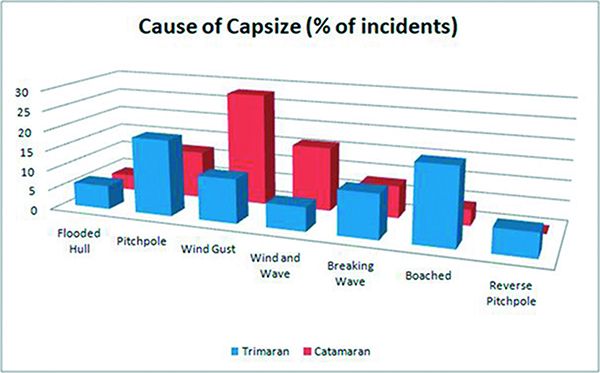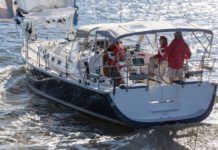Trimarans tend to be more performance oriented than catamarans. In part, this is because it’s easier to design a folding trimaran, and as a result Farrier, Corsair, and Dragonfly trimarans had a disproportionate share of the market.
In spite of this and in spite of the fact that many are raced aggressively in windy conditions, capsizes are few, certainly fewer than in equivalent performance catamaran classes. But when they do go over, they do so in different ways.

Trimarans have greater beam than catamarans, making them considerably more resistant to capsize by wind alone, whether gusts or sustained wind. They heel sooner and more than catamaran, giving more warning that they are over powered.
Waves are a different matter. The amas are generally much finer, designed for low resistance when sailing deeply immersed to windward. As a result, trimarans are more susceptible to broach and capsize when broad reaching at high speed or when caught on the beam by a large breaking wave.
In the first case, the boat is sailing fast and overtaking waves. You surf down a nice steep one, into the backside of the next one, the ama buries up to the beam and the boat slows down. The apparent wind increases, the following wave lifts the transom, and the boat slews into a broach. If all sail is instantly eased, the boat will generally come back down, even from scary levels of heel, but not always.
In the second case a large wave breaks under the boat, pulling the leeward ama down and rolling the boat. Catamarans, on the other hand, are more likely to slide sideways when hit by a breaking wave, particularly if the keels are shallow (or raised in the case of daggerboards), because the hulls are too big to be forced under. They simply get dragged to leeward, alerting the crew that it is time to start bearing off the wind.
Ama Design
Another place the numbers leave us short is ama design. In the 70s and 80s, most catamarans were designed with considerable flare in the bow, like other boats of the period. This will keep the bow from burying, right? Nope. When a hull is skinny it can always be driven through a wave, and wide flare causes a rapid increase in drag once submerged, causing the boat to slow and possibly pitchpole.
Hobie Cat sailors know this well. More modern designs either eliminate or minimize this flare, making for more predictable behavior in rough conditions. A classic case is the evolution of Ian Farrier’s designs from bows that flare above the waterline to a wave-piercing shape with little flare, no deck flange, increased forward volume, and reduced rocker (see photos page 18). After more than two decades of designing multihulls, Farrier saw clear advantages of the new bow form. The F-22 is a little faster, but more importantly, it is less prone to broach or pitchpole, allowing it to be driven harder.
Beam and Stability
The stability index goes up with beam. Why isn’t more beam always better? Because as beam increases, a pitchpole off the wind becomes more likely, both under sail and under bare poles. (The optimum length-to-beam ratios is 1.7:1 – 2.2:1 for cats and 1.2:1-1.8:1 for trimarans.) Again, hull shape and buoyancy also play critical roles in averting a pitchpole, so beam alone shouldn’t be regarded as a determining factor.
Drogues and Chutes
While monohull sailors circle the globe without ever needing their drogues and sea anchors, multihulls are more likely to use them. In part, this is because strategies such as heaving to and lying a hull don’t work for multihulls. Moderate beam seas cause an uncomfortable snap-roll, and sailing or laying ahull in a multihull is poor seamanship in beam seas.
Fortunately, drogues work better with multihulls. The boats are lighter, reducing loads. They rise over the waves, like a raft. Dangerous surfing, and the risk of pitchpole and broach that comes with it, is eliminated. There’s no deep keel to trip over to the side and the broad beam increases the lever arm, reducing yawing to a bare minimum.
Speed-limiting drogues are often used by delivery skippers simply to ease the motion and take some work off the autopilot. By keeping her head down, a wind-only capsize becomes extremely unlikely, and rolling stops, making for an easy ride. A properly sized drogue will keep her moving at 4-6 knots, but will not allow surfing, and by extension, pitch poling.
For more information on speed limiting drogues, see “How Much Drag is a Drogue?” PS, September 2016.

































